GIS-Based Comparative Study of the Bayesian Network, Decision Table, Radial Basis Function Network and Stochastic Gradient Descent for the Spatial Prediction of Landslide Susceptibility
Abstract
:1. Introduction
2. Study Area and Materials
2.1. Study Area
2.2. Landslide Inventory
2.3. Landslide-Related Variables
3. Methodology
3.1. Frequency Ratio (FR)
3.2. Feature Selection
3.3. Landslide Susceptibility Model
3.3.1. Bayesian Network (BN)
3.3.2. Decision Table (DTable)
3.3.3. Radial Basis Function Network (RBFN)
3.3.4. Stochastic Gradient Descent (SGD)
3.4. Model Evaluation and Comparison
4. Results and Analysis
4.1. FR Analysis
4.1.1. Topographic Variables
4.1.2. Geological Variables
4.1.3. Hydrological Variables
4.1.4. Environmental Variables
4.2. Feature Selection Analysis
4.3. Application of the Models
4.4. Performance and Comparison of Models
5. Discussion
6. Conclusions
Author Contributions
Funding
Institutional Review Board Statement
Informed Consent Statement
Data Availability Statement
Acknowledgments
Conflicts of Interest
References
- Juliev, M.; Mergili, M.; Mondal, I.; Nurtaev, B.; Pulatov, A.; Hubl, J. Comparative analysis of statistical methods for landslide susceptibility mapping in the Bostanlik District, Uzbekistan. Sci. Total Environ. 2019, 653, 801–814. [Google Scholar] [CrossRef] [PubMed]
- Reichenbach, P.; Busca, C.; Mondini, A.C.; Rossi, M. The Influence of Land Use Change on Landslide Susceptibility Zonation: The Briga Catchment Test Site (Messina, Italy). Environ. Manag. 2014, 54, 1372–1384. [Google Scholar] [CrossRef] [PubMed] [Green Version]
- Guzzetti, F.; Peruccacci, S.; Rossi, M.; Stark, C.P. The rainfall intensity-duration control of shallow landslides and debris flows: An update. Landslides 2008, 5, 3–17. [Google Scholar] [CrossRef]
- Zou, Q.; Jiang, H.; Cui, P.; Zhou, B.; Jiang, Y.; Qin, M.; Liu, Y.; Li, C. A new approach to assess landslide susceptibility based on slope failure mechanisms. Catena 2021, 204, 105388. [Google Scholar] [CrossRef]
- Clark, M.K.; Schoenbohm, L.M.; Royden, L.H.; Whipple, K.X.; Burchfiel, B.C.; Zhang, X.; Tang, W.; Wang, E.; Chen, L. Surface uplift, tectonics, and erosion of eastern Tibet from large-scale drainage patterns. Tectonics 2004, 23, 1–20. [Google Scholar] [CrossRef] [Green Version]
- Hetzel, R. Active faulting, mountain growth, and erosion at the margins of the Tibetan Plateau constrained by in situ-produced cosmogenic nuclides. Tectonophysics 2013, 582, 1–24. [Google Scholar] [CrossRef]
- Wang, G.; Huang, R.; Lourenço, S.D.N.; Kamai, T. A large landslide triggered by the 2008 Wenchuan (M8.0) earthquake in Donghekou area: Phenomena and mechanisms. Eng. Geol. 2014, 182, 148–157. [Google Scholar] [CrossRef] [Green Version]
- Huang, J.P.; Sun, C.W.; Wu, X.Y.; Ling, S.X.; Wang, S.; Deng, R. Stability assessment of tunnel slopes along the Dujiangyan City to Siguniang Mountain Railway, China. Bull. Eng. Geol. Environ. 2020, 79, 5309–5327. [Google Scholar] [CrossRef]
- Wu, R.A.; Zhang, Y.S.; Guo, C.B.; Yang, Z.H.; Tang, J.; Su, F.R. Landslide susceptibility assessment in mountainous area: A case study of Sichuan-Tibet railway, China. Environ. Earth Sci. 2020, 79, 157. [Google Scholar] [CrossRef]
- Quinn, P.E.; Hutchinson, D.J.; Diederichs, M.S.; Rowe, R.K. Regional-scale landslide susceptibility mapping using the weights of evidence method: An example applied to linear infrastructure. Can. Geotech. J. 2010, 47, 905–927. [Google Scholar] [CrossRef]
- Ngo, P.T.T.; Panahi, M.; Khosravi, K.; Ghorbanzadeh, O.; Kariminejad, N.; Cerda, A.; Lee, S. Evaluation of deep learning algorithms for national scale landslide susceptibility mapping of Iran. Geosci. Front. 2021, 12, 505–519. [Google Scholar]
- Brabb, E.E. Innovative approaches to landslide hazard mapping. In Proceedings of the Fourth International Symposium on Landslides, Canadian Geotechnical Society, Toronto, ON, Canada, 16–21 September 1984; pp. 307–324. [Google Scholar]
- Reichenbach, P.; Rossi, M.; Malamud, B.D.; Mihir, M.; Guzzetti, F. A review of statistically-based landslide susceptibility models. Earth-Sci. Rev. 2018, 180, 60–91. [Google Scholar] [CrossRef]
- Neuland, H. A prediction model of landslips. Catena 1976, 3, 215–230. [Google Scholar] [CrossRef]
- Merghadi, A.; Yunus, A.P.; Dou, J.; Whiteley, J.; ThaiPham, B.; Bui, D.T.; Avtar, R.; Abderrahmane, B. Machine learning methods for landslide susceptibility studies: A comparative overview of algorithm performance. Earth-Sci. Rev. 2020, 207, 103225. [Google Scholar] [CrossRef]
- Yilmaz, I. Landslide susceptibility mapping using frequency ratio, logistic regression, artificial neural networks and their comparison: A case study from Kat landslides (Tokat-Turkey). Comput. Geosci. 2009, 35, 1125–1138. [Google Scholar] [CrossRef]
- Goetz, J.N.; Brenning, A.; Petschko, H.; Leopold, P. Evaluating machine learning and statistical prediction techniques for landslide susceptibility modeling. Comput. Geosci. 2015, 81, 1–11. [Google Scholar] [CrossRef]
- Huang, F.M.; Cao, Z.S.; Guo, J.F.; Jiang, S.H.; Li, S.; Guo, Z.Z. Comparisons of heuristic, general statistical and machine learning models for landslide susceptibility prediction and mapping. Catena 2020, 191, 104580. [Google Scholar] [CrossRef]
- Chen, W.; Zhang, S.; Li, R.W.; Shahabi, H. Performance evaluation of the GIS-based data mining techniques of best-first decision tree, random forest, and naive Bayes tree for landslide susceptibility modeling. Sci. Total Environ. 2018, 644, 1006–1018. [Google Scholar] [CrossRef] [PubMed]
- Pham, B.T.; Pradhan, B.; Bui, D.T.; Prakash, I.; Dholakia, M.B. A comparative study of different machine learning methods for landslide susceptibility assessment: A case study of Uttarakhand area (India). Environ. Modell. Softw. 2016, 84, 240–250. [Google Scholar] [CrossRef]
- Yi, Y.N.; Zhang, Z.J.; Zhang, W.C.; Jia, H.H.; Zhang, J.Q. Landslide susceptibility mapping using multiscale sampling strategy and convolutional neural network: A case study in Jiuzhaigou region. Catena 2020, 195, 104851. [Google Scholar] [CrossRef]
- Youssef, A.M.; Pourghasemi, H.R.; Pourtaghi, Z.S.; Al-Katheeri, M.M. Landslide susceptibility mapping using random forest, boosted regression tree, classification and regression tree, and general linear models and comparison of their performance at Wadi Tayyah Basin, Asir Region, Saudi Arabia. Landslides 2016, 13, 839–856. [Google Scholar] [CrossRef]
- Chen, W.W.; Zhang, S. GIS-based comparative study of Bayes network, Hoeffding tree and logistic model tree for landslide susceptibility modeling. Catena 2021, 203, 105344. [Google Scholar] [CrossRef]
- Zhang, S.T.; Wang, F.F.; Duo, F.; Zhang, J.L. Research on the Majority Decision Algorithm based on WeChat sentiment classification. J. Intell. Fuzzy Syst. 2018, 35, 2975–2984. [Google Scholar] [CrossRef]
- Bui, D.T.; Shahabi, H.; Omidvar, E.; Shirzadi, A.; Geertsema, M.; Clague, J.J.; Khosravi, K.; Pradhan, B.; Pham, B.T.; Chapi, K.; et al. Shallow Landslide Prediction Using a Novel Hybrid Functional Machine Learning Algorithm. Remote Sens. 2019, 11, 931. [Google Scholar]
- Hong, H.Y.; Tsangaratos, P.; Ilia, I.; Loupasakis, C.; Wang, Y. Introducing a novel multi-layer perceptron network based on stochastic gradient descent optimized by a meta-heuristic algorithm for landslide susceptibility mapping. Sci. Total Environ. 2020, 742, 140549. [Google Scholar] [CrossRef] [PubMed]
- Nhu, V.H.; Hoang, N.D.; Nguyen, H.; Ngo, P.T.T.; Bui, T.T.; Hoa, P.V.; Samui, P.; Bui, D.T. Effectiveness assessment of Keras based deep learning with different robust optimization algorithms for shallow landslide susceptibility mapping at tropical area. Catena 2020, 188, 104458. [Google Scholar] [CrossRef]
- Wang, W.D.; He, Z.L.; Han, Z.; Li, Y.G.; Dou, J.; Huang, J.L. Mapping the susceptibility to landslides based on the deep belief network: A case study in Sichuan Province, China. Nat. Hazards 2020, 103, 3239–3261. [Google Scholar] [CrossRef]
- Song, Y.Q.; Gong, J.H.; Gao, S.; Wang, D.C.; Cui, T.J.; Li, Y.; Wei, B.Q. Susceptibility assessment of earthquake-induced landslides using Bayesian network: A case study in Beichuan, China. Comput. Geosci. 2012, 42, 189–199. [Google Scholar] [CrossRef]
- Lee, S.; Lee, M.J.; Jung, H.S.; Lee, S. Landslide susceptibility mapping using Naive Bayes and Bayesian network models in Umyeonsan, Korea. Geocarto Int. 2020, 35, 1665–1679. [Google Scholar] [CrossRef]
- Pham, B.T.; Trung, N.T.; Qi, C.C.; Phong, T.V.; Dou, J.; Ho, L.S.; Le, H.V.; Prakash, I. Coupling RBF neural network with ensemble learning techniques for landslide susceptibility mapping. Catena 2020, 195, 104805. [Google Scholar] [CrossRef]
- Pham, B.T.; Vu, V.D.; Costache, R.; Phong, T.V.; Ngo, T.Q.; Tran, T.H.; Nguyen, H.D.; Amiri, M.; Tan, M.T.; Trinh, P.T.; et al. Landslide susceptibility mapping using state-of-the-art machine learning ensembles. Geocarto Int. 2021, 36, 1–26. [Google Scholar] [CrossRef]
- Deng, B.; Liu, S.G.; Jansa, L.; Cao, J.X.; Cheng, Y.; Li, Z.W.; Liu, S. Sedimentary record of Late Triassic transpressional tectonics of the Longmenshan thrust belt, SW China. J. Asian Earth Sci. 2012, 48, 43–55. [Google Scholar] [CrossRef]
- Li, Y.; Cao, S.; Zhou, R.; Densmore, A.L.; Ellis, M.A. Late Cenozoic Minjiang Incision Rate and Its Constraint on the Uplift of the Eastern Margin of the Tibetan Plateau. Acta Geol. Sin. 2005, 79, 28–37. [Google Scholar]
- Hungr, O.; Leroueil, S.; Picarelli, L. The Varnes classification of landslide types, an update. Landslides 2014, 11, 167–194. [Google Scholar] [CrossRef]
- Chen, W.; Chen, X.; Peng, J.B.; Panahi, M.; Lee, S. Landslide susceptibility modeling based on ANFIS with teaching-learning-based optimization and Satin bowerbird optimizer. Geosci. Front. 2021, 12, 93–107. [Google Scholar] [CrossRef]
- Youssef, A.M.; Pradhan, B.; Jebur, M.N.; El-Harbi, H.M. Landslide susceptibility mapping using ensemble bivariate and multivariate statistical models in Fayfa area, Saudi Arabia. Environ. Earth Sci. 2015, 73, 3745–3761. [Google Scholar] [CrossRef]
- Shao, X.Y.; Ma, S.Y.; Xu, C.; Zhang, P.F.; Wen, B.Y.; Tian, Y.Y.; Zhou, Q.; Cui, Y.L. Planet Image-Based Inventorying and Machine Learning-Based Susceptibility Mapping for the Landslides Triggered by the 2018 Mw6.6 Tomakomai, Japan Earthquake. Remote Sens. 2019, 11, 978. [Google Scholar] [CrossRef] [Green Version]
- Rahman, M.; Chen, N.S.; Elbeltagi, A.; Islam, M.M.; Alam, M.; Pourghasemi, H.R.; Tao, W.; Zhang, J.; Tian, S.F.; Faiz, H.; et al. Application of stacking hybrid machine learning algorithms in delineating multi-type flooding in Bangladesh. J. Environ. Manag. 2021, 295, 113086. [Google Scholar] [CrossRef]
- Zhao, Y.; Wang, R.; Jiang, Y.J.; Liu, H.J.; Wei, Z.L. GIS-based logistic regression for rainfall-induced landslide susceptibility mapping under different grid sizes in Yueqing, Southeastern China. Eng. Geol. 2019, 259, 105147. [Google Scholar] [CrossRef]
- Kavzoglu, T.; Sahin, E.K.; Colkesen, I. Selecting optimal conditioning factors in shallow translational landslide susceptibility mapping using genetic algorithm. Eng. Geol. 2015, 192, 101–112. [Google Scholar] [CrossRef]
- Chen, W.; Xie, X.; Wang, J.; Pradhan, B.; Hong, H.; Bui, D.T.; Duan, Z.; Ma, J. A comparative study of logistic model tree, random forest, and classification and regression tree models for spatial prediction of landslide susceptibility. Catena 2017, 151, 147–160. [Google Scholar] [CrossRef] [Green Version]
- Tsangaratos, P.; Ilia, I. Comparison of a logistic regression and Naive Bayes classifier in landslide susceptibility assessments: The influence of models complexity and training dataset size. Catena 2016, 145, 164–179. [Google Scholar] [CrossRef]
- Wang, Y.; Fang, Z.C.; Hong, H.Y.; Costache, R.; Tang, X.Z. Flood susceptibility mapping by integrating frequency ratio and index of entropy with multilayer perceptron and classification and regression tree. J. Environ. Manag. 2021, 289, 112449. [Google Scholar] [CrossRef]
- Lee, S.; Pradhan, B. Landslide hazard mapping at Selangor, Malaysia using frequency ratio and logistic regression models. Landslides 2007, 4, 33–41. [Google Scholar] [CrossRef]
- Shahabi, H.; Shirzadi, A.; Ronoud, S.; Asadi, S.; Pham, B.T.; Mansouripour, F.; Geertsema, M.; Clague, J.J.; Bui, D.T. Flash flood susceptibility mapping using a novel deep learning model based on deep belief network, back propagation and genetic algorithm. Geosci. Front. 2021, 12, 101100. [Google Scholar] [CrossRef]
- Chen, X.; Chen, W. GIS-based landslide susceptibility assessment using optimized hybrid machine learning methods. Catena 2021, 196, 104833. [Google Scholar] [CrossRef]
- Holte, R.C. Very Simple Classification Rules Perform Well on Most Commonly Used Datasets. Mach. Learn. 1993, 11, 63–91. [Google Scholar] [CrossRef]
- Pes, B. Ensemble feature selection for high-dimensional data: A stability analysis across multiple domains. Neural Comput. Appl. 2020, 32, 5951–5973. [Google Scholar] [CrossRef] [Green Version]
- Luu, C.; Pham, B.T.; Phong, T.V.; Costache, R.; Nguyen, H.D.; Amiri, M.; Bui, Q.D.; Nguyen, L.T.; Le, H.V.; Prakash, I.; et al. GIS-based ensemble computational models for flood susceptibility prediction in the Quang Binh Province, Vietnam. J. Hydrol. 2021, 599, 126500. [Google Scholar] [CrossRef]
- Pearl, J. Chapter 3—Markov and Bayesian Networks: Two Graphical Representations of Probabilistic Knowledge. In Probabilistic Reasoning in Intelligent Systems; Pearl, J., Ed.; Morgan Kaufmann: San Francisco, CA, USA, 1988; pp. 77–141. [Google Scholar]
- Wu, Z.N.; Shen, Y.X.; Wang, H.L.; Wu, M.M. Assessing urban flood disaster risk using Bayesian network model and GIS applications. Geomat. Nat. Haz. Risk 2019, 10, 2163–2184. [Google Scholar] [CrossRef] [Green Version]
- Lu, Q.W.; Zhong, P.A.; Xu, B.; Zhu, F.L.; Ma, Y.F.; Wang, H.; Xu, S.Y. Risk analysis for reservoir flood control operation considering two- dimensional uncertainties based on Bayesian network. J. Hydrol. 2020, 589, 125353. [Google Scholar] [CrossRef]
- Kohavi, R. The power of decision tables. In Proceedings of the Machine Learning: ECML-95, Berlin/Heidelberg, Germany, 25–27 April 1995; pp. 174–189. [Google Scholar]
- He, Q.F.; Shahabi, H.; Shirzadi, A.; Li, S.J.; Chen, W.; Wang, N.Q.; Chai, H.C.; Bian, H.Y.; Ma, J.Q.; Chen, Y.T.; et al. Landslide spatial modelling using novel bivariate statistical based Naive Bayes, RBF Classifier, and RBF Network machine learning algorithms. Sci. Total Environ. 2019, 663, 1–15. [Google Scholar] [CrossRef] [PubMed]
- Moody, J.; Darken, C.J. Fast Learning in Networks of Locally-Tuned Processing Units. Neural Comput. 1989, 1, 281–294. [Google Scholar] [CrossRef]
- Chang, F.J.; Chen, Y.C. Estuary water-stage forecasting by using radial basis function neural network. J. Hydrol. 2003, 270, 158–166. [Google Scholar] [CrossRef]
- El Bilali, A.; Taleb, A.; Nafii, A.; Alabjah, B.; Mazigh, N. Prediction of sodium adsorption ratio and chloride concentration in a coastal aquifer under seawater intrusion using machine learning models. Environ. Technol. Inno. 2021, 23, 101641. [Google Scholar] [CrossRef]
- Le, H.V.; Hoang, D.A.; Tran, C.T.; Nguyen, P.Q.; Tran, V.H.T.; Hoang, N.D.; Amiri, M.; Ngo, T.P.T.; Nhu, H.V.; Hoang, T.V.; et al. A new approach of deep neural computing for spatial prediction of wildfire danger at tropical climate areas. Ecol. Inform. 2021, 63, 101300. [Google Scholar] [CrossRef]
- Pham, B.T.; Phong, T.V.; Trung, N.T.; Parial, K.; Singh, S.K.; Ly, H.B.; Nguyen, K.T.; Ho, L.S.; Le, H.V.; Prakash, I. Ensemble modeling of landslide susceptibility using random subspace learner and different decision tree classifiers. Geocarto Int. 2020, 36, 1–23. [Google Scholar] [CrossRef]
- Xie, W.; Li, X.S.; Jian, W.B.; Yang, Y.; Liu, H.W.; Robledo, L.F.; Nie, W. A Novel Hybrid Method for Landslide Susceptibility Mapping-Based GeoDetector and Machine Learning Cluster: A Case of Xiaojin County, China. Isprs Int. J. Geo-Inf. 2021, 10, 93. [Google Scholar] [CrossRef]
- Lei, Y.W.; Tang, K. Learning Rates for Stochastic Gradient Descent with Nonconvex Objectives. IEEE T. Pattern Anal. 2021, 43, 4505–4511. [Google Scholar] [CrossRef] [PubMed]
- Tang, M.Q.; Ren, C.J.; Xin, Y.L. Efficient Resource Allocation Algorithm for Underwater Wireless Sensor Networks Based on Improved Stochastic Gradient Descent Method. Ad Hoc Sens. Wirel. Netw. 2021, 49, 207–222. [Google Scholar]
- Lei, Y.W.; Hu, T.; Tang, K. Generalization Performance of Multi-pass Stochastic Gradient Descent with Convex Loss Functions. J. Mach. Learn. Res. 2021, 22, 25–41. [Google Scholar]
- Barani, F.; Savadi, A.; Yazdi, H.S. Convergence behavior of diffusion stochastic gradient descent algorithm. Signal Process. 2021, 183, 108014. [Google Scholar] [CrossRef]
- Lyu, X.C.; Ren, C.S.; Ni, W.; Tian, H.; Liu, R.P.; Tao, X.F. Distributed Online Learning of Cooperative Caching in Edge Cloud. IEEE T. Mobile Comput. 2021, 20, 2550–2562. [Google Scholar] [CrossRef]
- Kim, E.H.; Ko, J.H.; Oh, S.K.; Seo, K. Design of meteorological pattern classification system based on FCM-based radial basis function neural networks using meteorological radar data. Soft Comput. 2019, 23, 1857–1872. [Google Scholar] [CrossRef]
- Zhao, F.M.; Meng, X.M.; Zhang, Y.; Chen, G.; Su, X.J.; Yue, D.X. Landslide Susceptibility Mapping of Karakorum Highway Combined with the Application of SBAS-InSAR Technology. Sensors 2019, 19, 2685. [Google Scholar] [CrossRef] [PubMed] [Green Version]
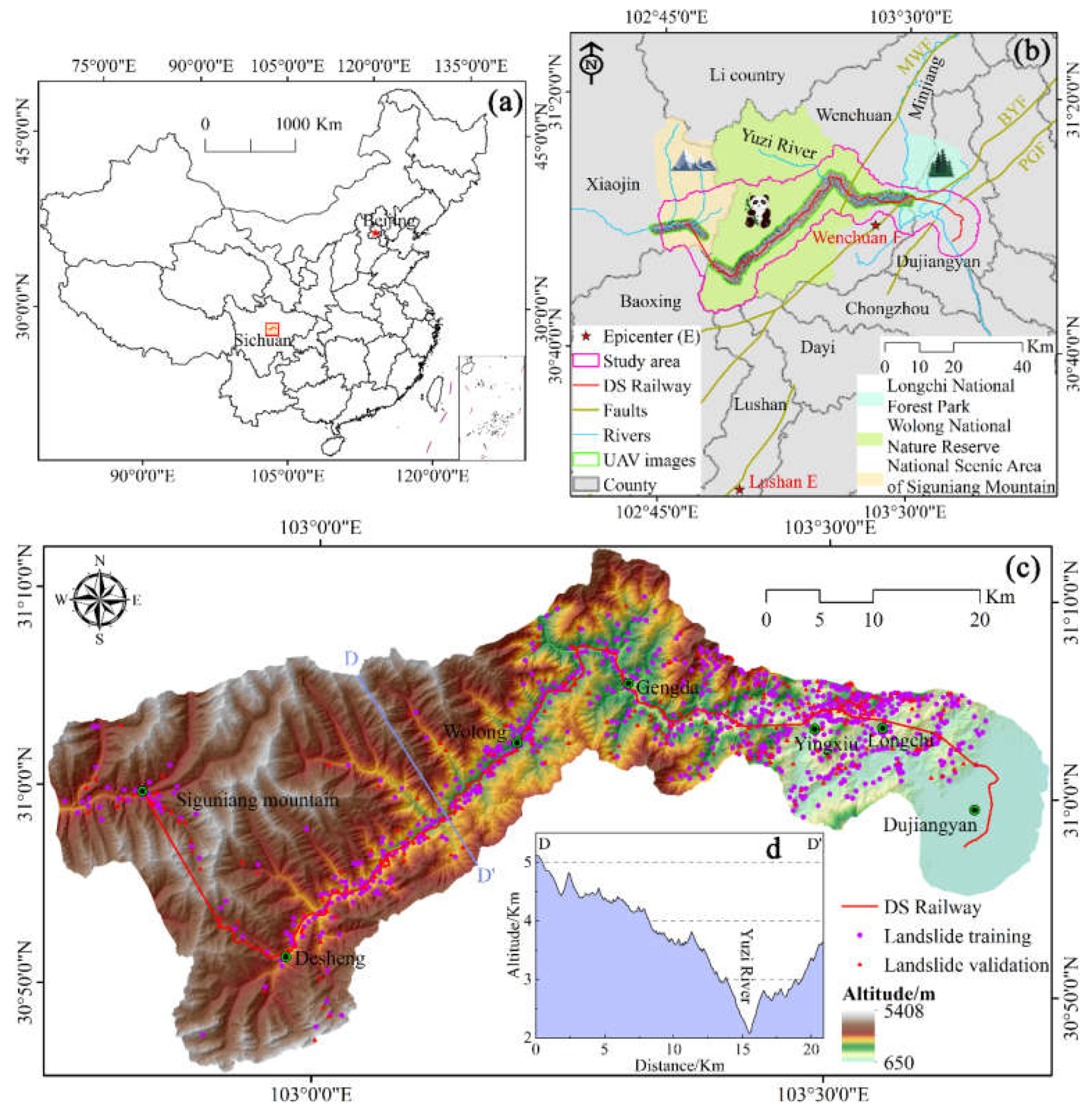

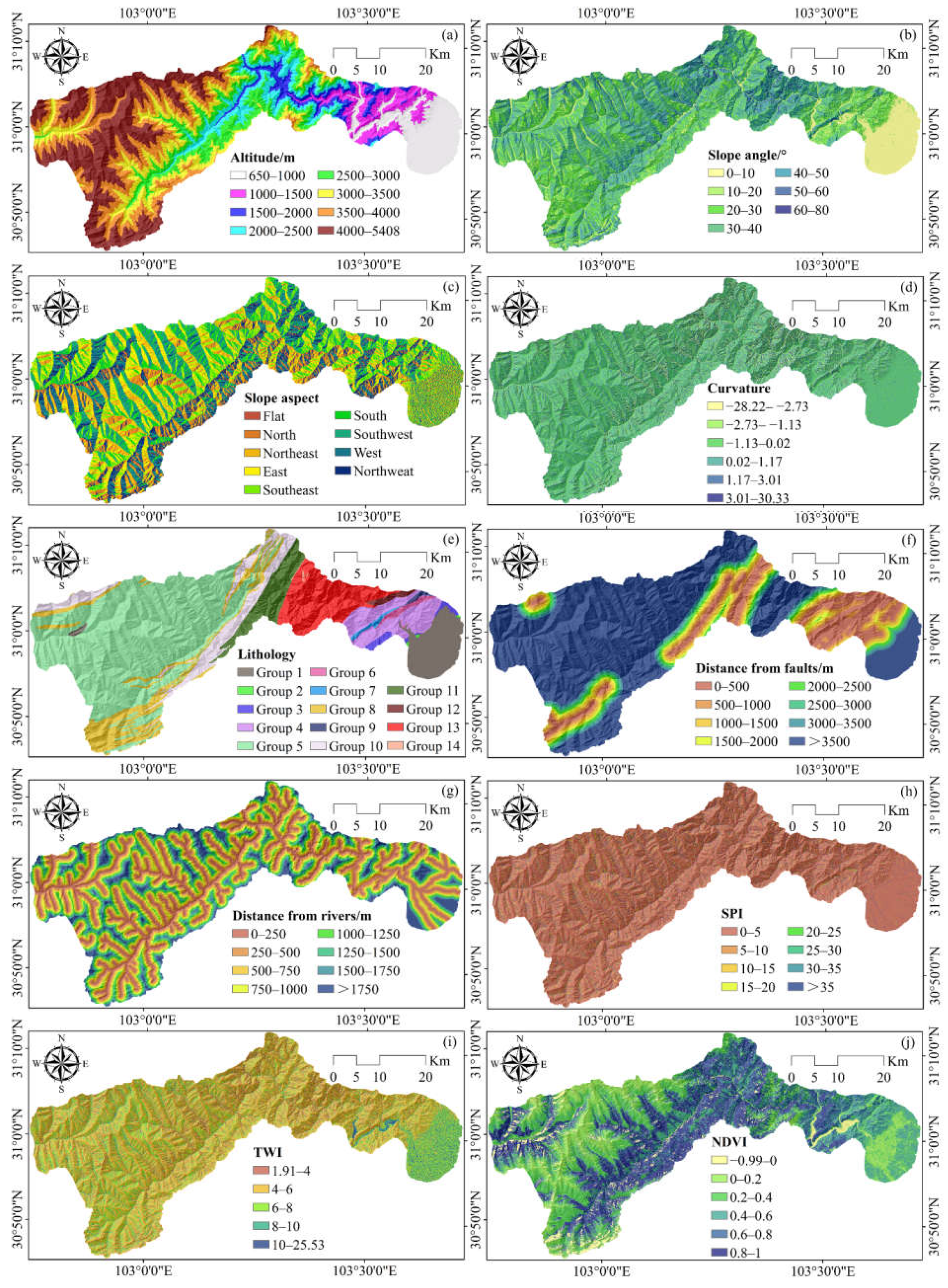
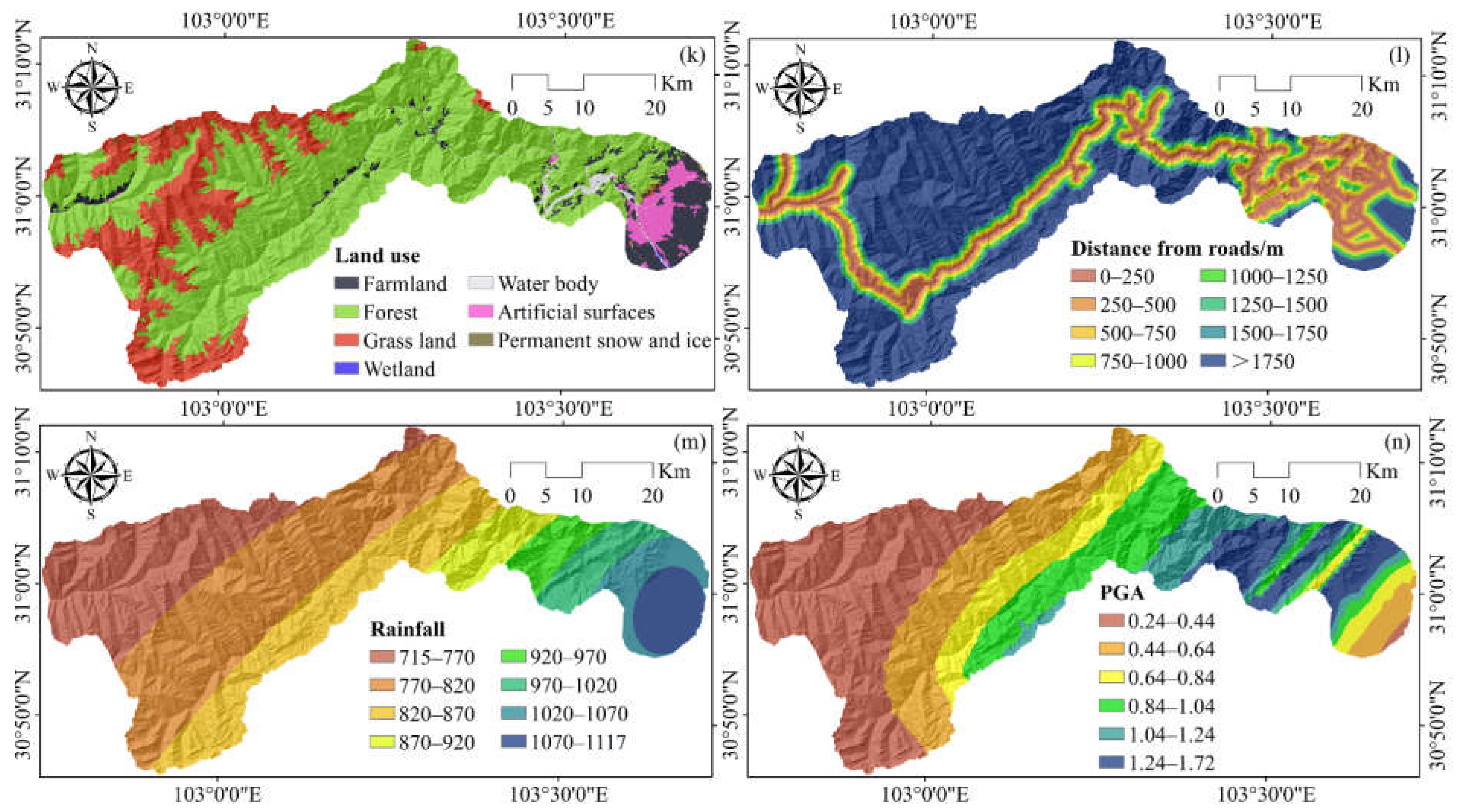
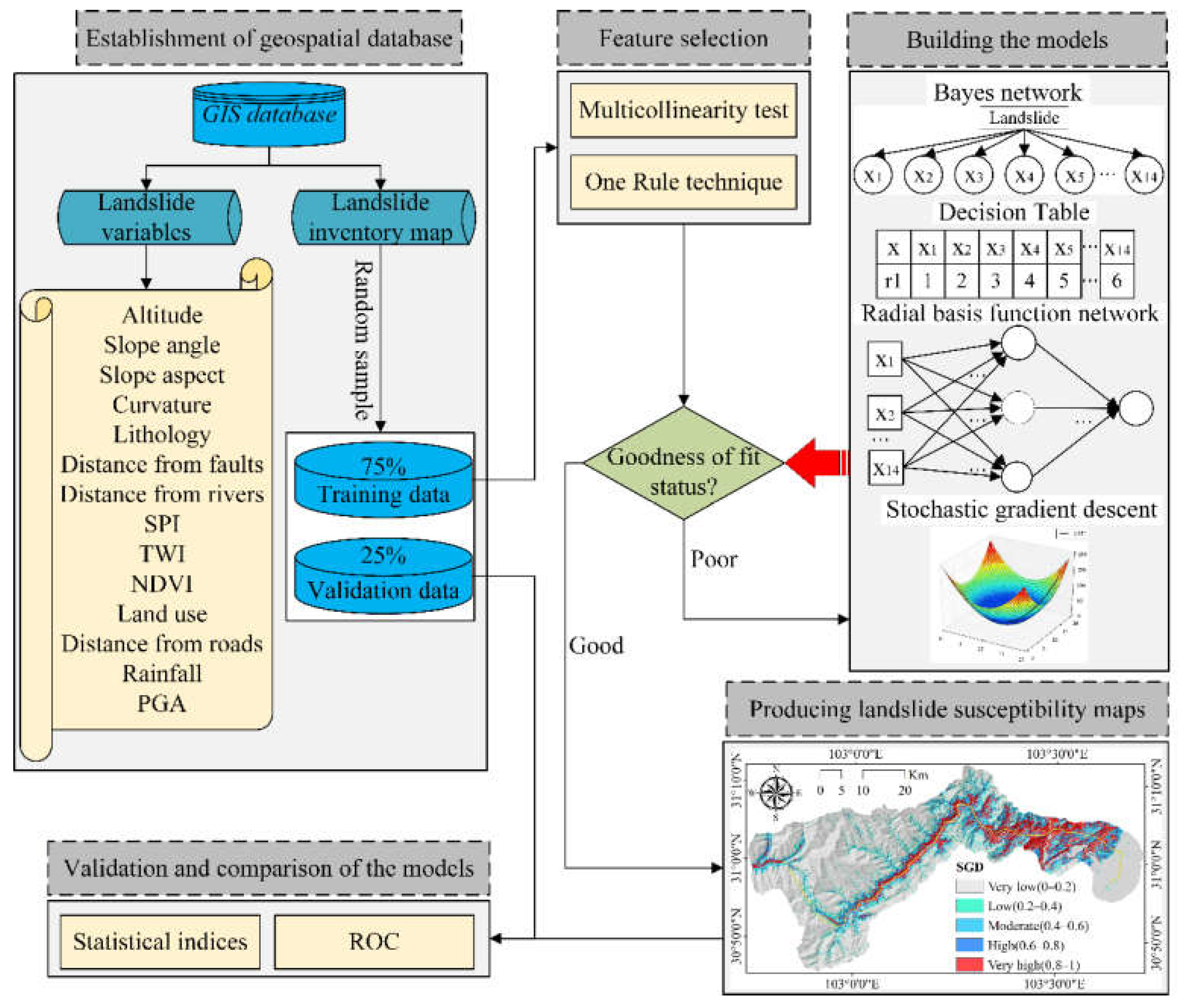
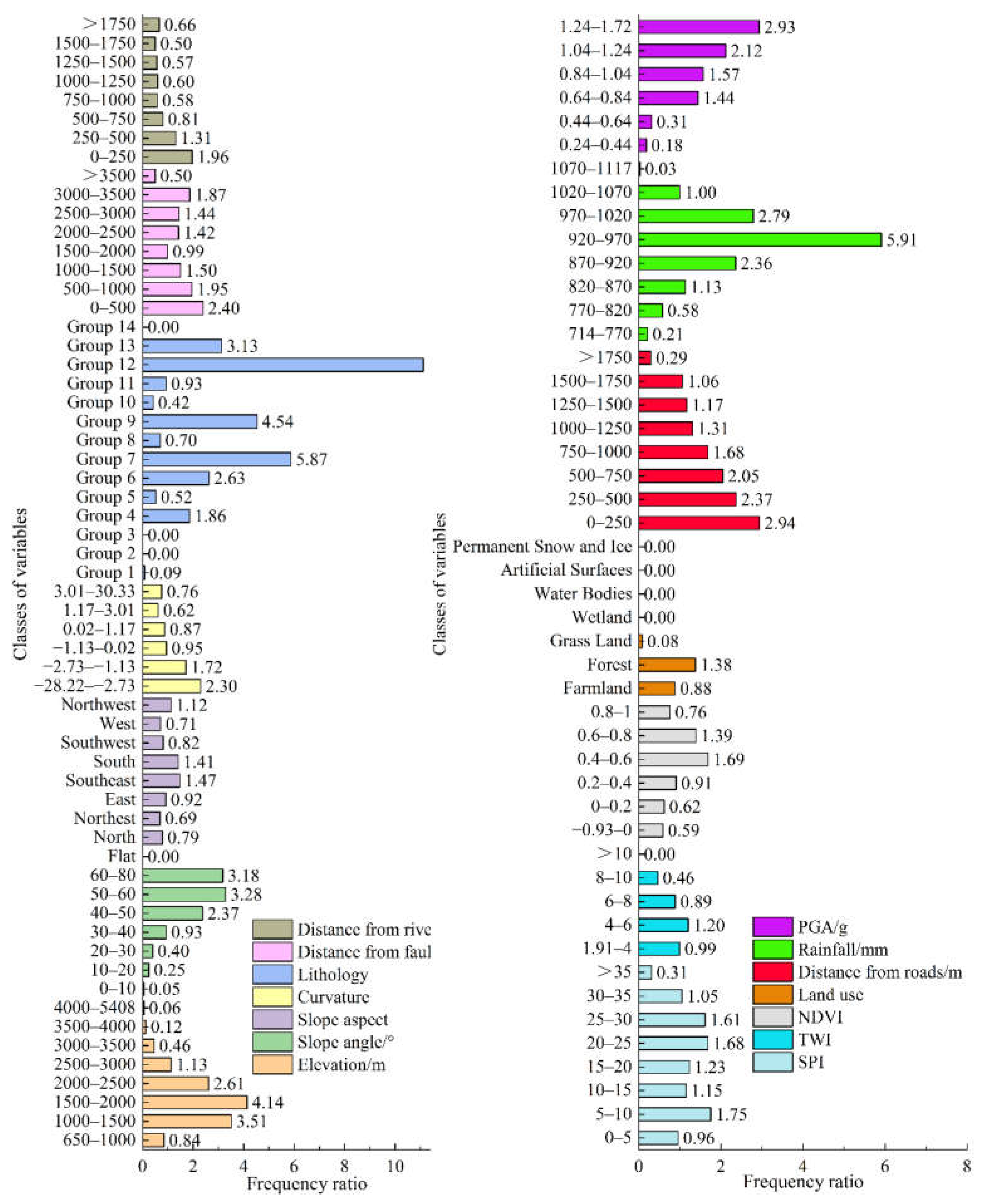

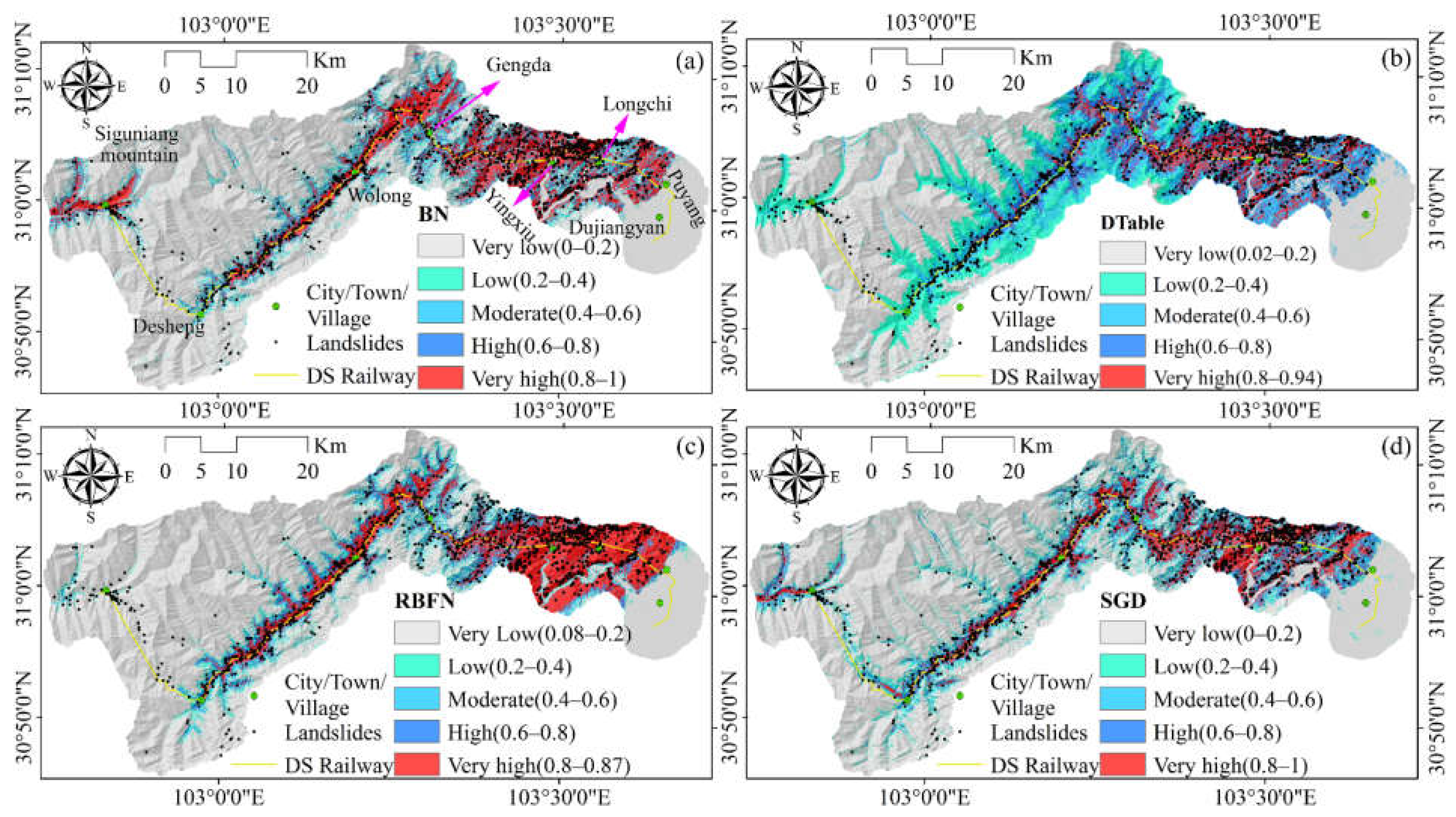

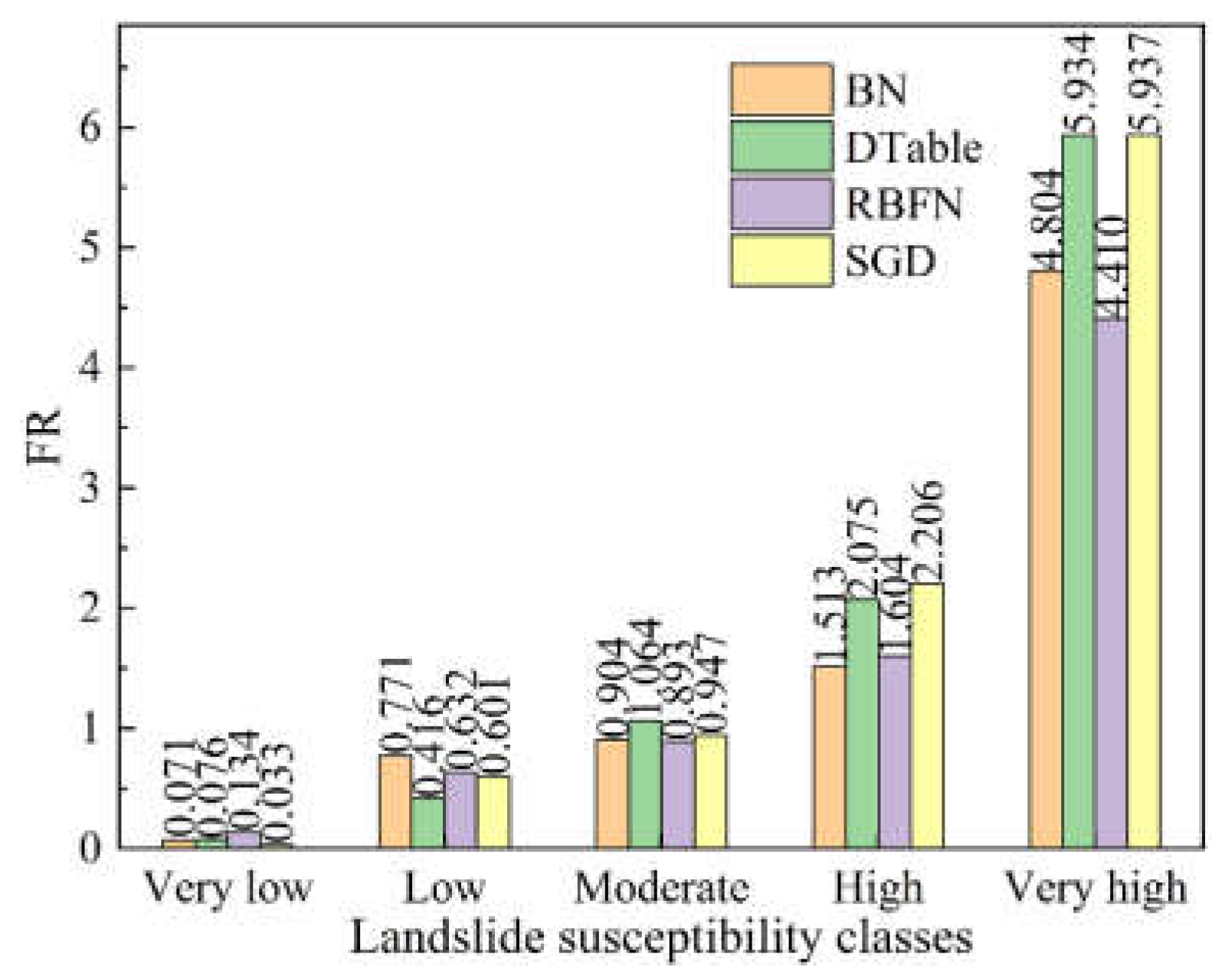

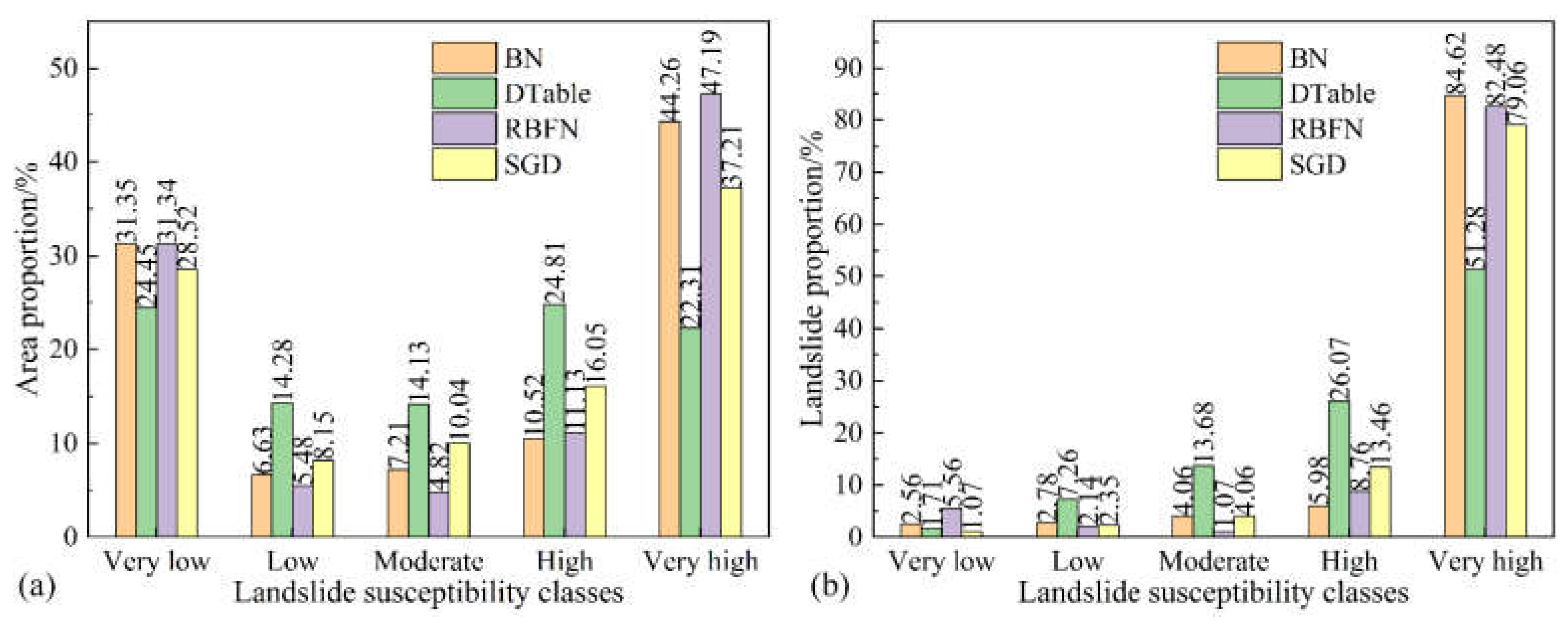

| Variables | Classes (j) | Descriptions of Variables | Classified Method/Number of Classes (m) | Resolution (Scale) |
|---|---|---|---|---|
| Altitude/m | 650–1000; 1000–1500; 1500–2000; 2000–2500; 2500–3000; 3000–3500; 3500–4000; 4000–5408 | Potential energy, vegetation, temperature, rainfall, and human activities always change with altitude, resulting in the development of landslides within a certain range of altitudes. | Equal interval/8 | 30 × 30 m |
| Slope angle/° | 0–10; 10–20; 20–30; 30–40; 40–50; 50–60; 60–80 | Slope angle affects the stress distribution, thickness of loose solid matter, vegetation coverage, and surface water runoff. | Equal interval/7 | 30 × 30 m |
| Slope aspect | Flat; N; NE; E; SE; S; SW; W; NW | Slope aspect affects the vegetation cover, water evaporation, and weathering degree of the hillslope. | Equal interval/9 | 30 × 30 m |
| Curvature | [(−28.22)–(−2.73)]; [(−2.73)–(−1.13)]; [(−1.13)–0.02]; [0.02–1.17]; [1.17–3.01]; [3.01–30.33] | Curvature affects the internal stress of hillslope and the runoff of surface water. | Natural break/6 | 30 × 30 m |
| Lithology | Group 1; group 2; group 3; group 4; group 5; group 6; group 7; group 8; group 9; group 10; group 11; group 12; group 13; group 14 | Lithology is the material basis of landslide disasters, which affects the difficulty of hillslope erosion. The group details are shown in Table 2. | Lithofacies/14 | 1:200,000 |
| Distance from faults/m | 0–500; 500–1000; 1000–1500; 1500–2000; 2000–2500; 2500–3000; 3000–3500; >3500 | Faults destroy the integrity of rock masses and provide channels for groundwater flow. | Equal interval/8 | 1:200,000 |
| Distance from rivers/m | 0–250; 250–500; 500–750; 750–1000; 1000–1250; 1250–1500; 1500–1750; >1750 | The river can erode and soften the hillslope toe, thus reducing the shear strength of the hillslope. | Equal interval/8 | 30 × 30 m |
| SPI | 0–5; 5–10; 10–15; 15–20; 20–25; 25–30; 30–35; >35 | can describe the potential erosion capacity of water flow at a given location in a watershed, where As is the specific catchment area (m2/m) and β is the slope angle (°). | Equal interval/8 | 30 × 30 m |
| TWI | 1.94–4; 4–6; 6–8; 8–10; >10 | is an indicator of surface soil moisture, which can quantitatively evaluate the runoff trend and the location of runoff convergence. | Equal interval/5 | 30 × 30 m |
| NDVI | (−0.95)–0; 0–0.2; 0.2–0.4; 0.4–0.6; 0.6–0.8; 0.8–1 | NDVI has been widely employed to measure the degree of vegetation development, which is related to hillslope runoff, infiltration, and weathering [36]. | Equal interval/6 | 10 × 10 m |
| Land use | Farmland; forest; grass land; wetland; water bodies; artificial surfaces; permanent snow and ice | Different land-use types have different effects on landslides, and unreasonable land use can aggravate landslides. | Land use unit/7 | 30 × 30 m |
| Distance from roads/m | 0–250; 250–500; 500–750; 750–1000; 1000–1250; 1250–1500; 1500–1750; >1750 | Road construction always influences changing in hillslope geometry, stress and hydrology [37]. | Equal interval/8 | 1:50,000 |
| Rainfall/mm | 717–770; 770–820; 820–870; 870–920; 920–970; 970–1020; 1020–1070; 1070–1117 | Rainfall can erode the hillslope surface, destroy the surface integrity of rock and soil masses, and reduce the shear strength of rock and soil masses. | Equal interval/8 | 30 × 30 m |
| PGA/g | 0.24–0.44; 0.44–0.64; 0.64–0.84; 0.84–1.04; 1.04–1.24; 1.24–1.72 | One of the main indicators of an earthquake, as well as a direct trigger of seismic landslides [38]. | Equal interval/6 | 30 × 30 m |
| Classification | Code | Lithology | Geological Age | Area/km2 |
|---|---|---|---|---|
| Group 1 | Q2, Q4 | Alluvium and colluvial sediments | Quaternary | 133.57 |
| Group 2 | K2g, K1j | Quartz sandstone, siltstone, and sandy mudstone | Cretaceous | 1.31 |
| Group 3 | J3l, J2sn, J2s | Sandstone, siltstone, sandy mudstone, and calcareous conglomerate | Jurassic | 15.00 |
| Group 4 | T3 | Conglomerate, feldspathic quartz sandstone, siltstone with shale and thin coal layer | Upper Triassic | 120.23 |
| Group 5 | T1, T2, T3 | Metasandstone, phyllite, crystalline limestone | Triassic | 871.64 |
| Group 6 | P1 | Dolomitic limestone, argillaceous limestone | Permian | 14.38 |
| Group 7 | C | Limestone intercalated with calcareous shale, mudstone | Carboniferous | 8.95 |
| Group 8 | C, T | Crystalline limestone, altered basalt, and phyllite | Carboniferous and Triassic | 192.52 |
| Group 9 | D2, D3 | Limestone, dolomite, sandstone, and shale | Devonian | 5.07 |
| Group 10 | Dwg | Phyllite with quartzite and crystalline limestone | Devonian | 149.28 |
| Group 11 | Smx | Phyllite, quartzite, crystalline limestone, metamorphic siltstone | Silurian | 98.66 |
| Group 12 | Za | Andesite, rhyolite, tuff lava, breccia agglomerate | Sinian | 11.68 |
| Group 13 | γο2(4), γδ2(3), γδ2(4), δο2(3) | Plagioclase granite, diorite, granodiorite, and diabase | Proterozoic | 189.24 |
| Group 14 | Pthn | Gabbro, diorite and quartz diorite | Proterozoic | 2.03 |
| Parameters | Training Dataset | Validation Dataset | ||||||
|---|---|---|---|---|---|---|---|---|
| SGD | BN | RBFN | DTable | SGD | BN | RBFN | DTable | |
| True positive | 758 | 751 | 726 | 688 | 232 | 231 | 219 | 216 |
| True negative | 682 | 679 | 664 | 668 | 215 | 204 | 208 | 206 |
| False positive | 146 | 149 | 164 | 160 | 61 | 72 | 68 | 70 |
| False negative | 70 | 77 | 102 | 140 | 44 | 45 | 57 | 60 |
| PPR/% | 83.85 | 83.44 | 81.57 | 81.13 | 79.18 | 76.24 | 76.31 | 75.52 |
| NPR/% | 90.69 | 89.81 | 86.68 | 82.67 | 83.01 | 81.93 | 78.49 | 77.44 |
| Sensitivity/% | 91.55 | 90.70 | 87.68 | 83.09 | 84.06 | 83.70 | 79.35 | 78.26 |
| Specificity/% | 82.37 | 82.00 | 80.19 | 80.67 | 77.90 | 73.91 | 75.36 | 74.64 |
| ACC/% | 86.96 | 86.35 | 83.94 | 81.88 | 80.98 | 78.80 | 77.36 | 76.45 |
| F1 | 0.88 | 0.87 | 0.85 | 0.82 | 0.82 | 0.80 | 0.78 | 0.77 |
| k | 0.74 | 0.73 | 0.68 | 0.64 | 0.62 | 0.58 | 0.55 | 0.53 |
Publisher’s Note: MDPI stays neutral with regard to jurisdictional claims in published maps and institutional affiliations. |
© 2022 by the authors. Licensee MDPI, Basel, Switzerland. This article is an open access article distributed under the terms and conditions of the Creative Commons Attribution (CC BY) license (https://creativecommons.org/licenses/by/4.0/).
Share and Cite
Huang, J.; Ling, S.; Wu, X.; Deng, R. GIS-Based Comparative Study of the Bayesian Network, Decision Table, Radial Basis Function Network and Stochastic Gradient Descent for the Spatial Prediction of Landslide Susceptibility. Land 2022, 11, 436. https://doi.org/10.3390/land11030436
Huang J, Ling S, Wu X, Deng R. GIS-Based Comparative Study of the Bayesian Network, Decision Table, Radial Basis Function Network and Stochastic Gradient Descent for the Spatial Prediction of Landslide Susceptibility. Land. 2022; 11(3):436. https://doi.org/10.3390/land11030436
Chicago/Turabian StyleHuang, Junpeng, Sixiang Ling, Xiyong Wu, and Rui Deng. 2022. "GIS-Based Comparative Study of the Bayesian Network, Decision Table, Radial Basis Function Network and Stochastic Gradient Descent for the Spatial Prediction of Landslide Susceptibility" Land 11, no. 3: 436. https://doi.org/10.3390/land11030436
APA StyleHuang, J., Ling, S., Wu, X., & Deng, R. (2022). GIS-Based Comparative Study of the Bayesian Network, Decision Table, Radial Basis Function Network and Stochastic Gradient Descent for the Spatial Prediction of Landslide Susceptibility. Land, 11(3), 436. https://doi.org/10.3390/land11030436






